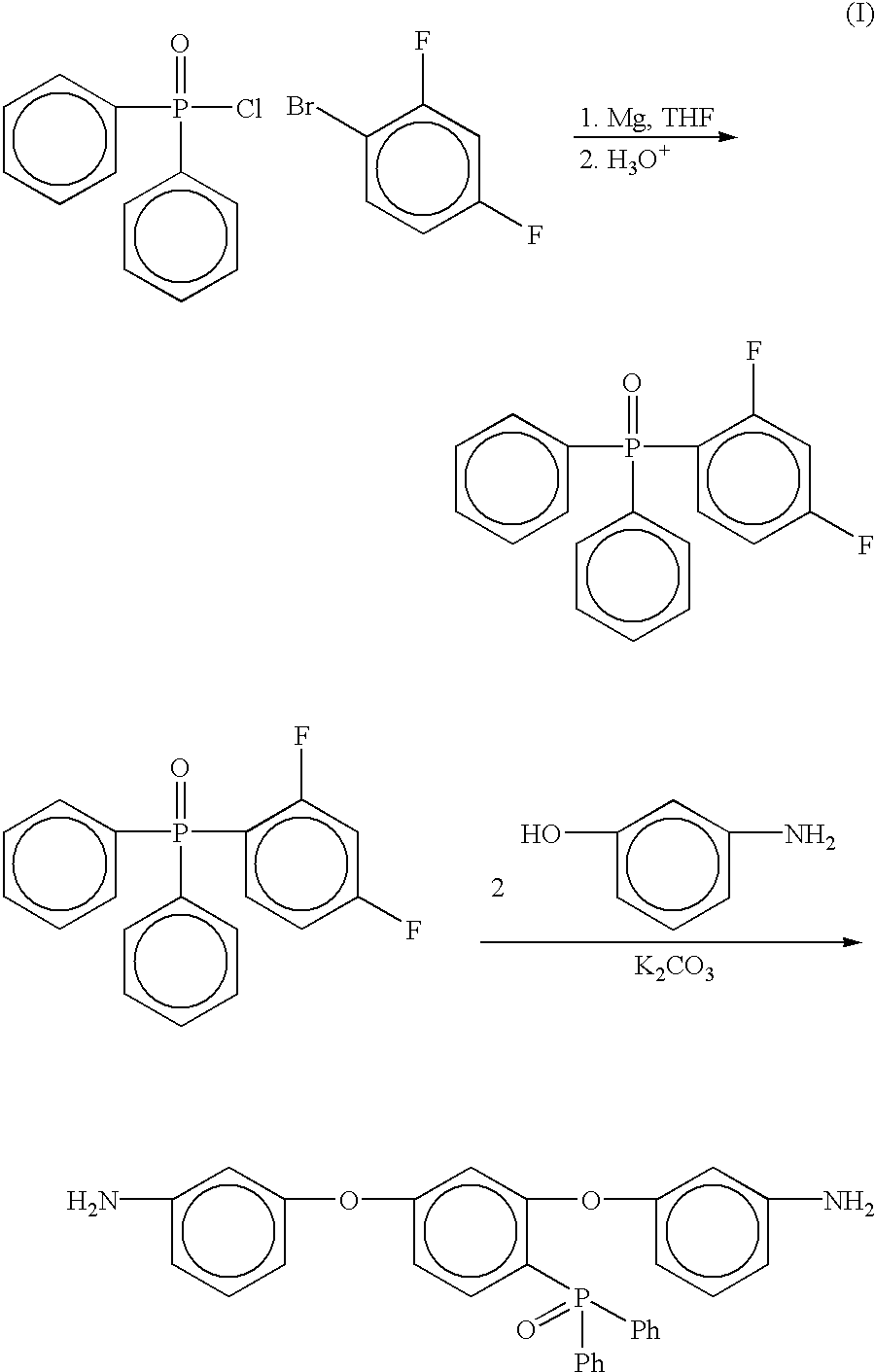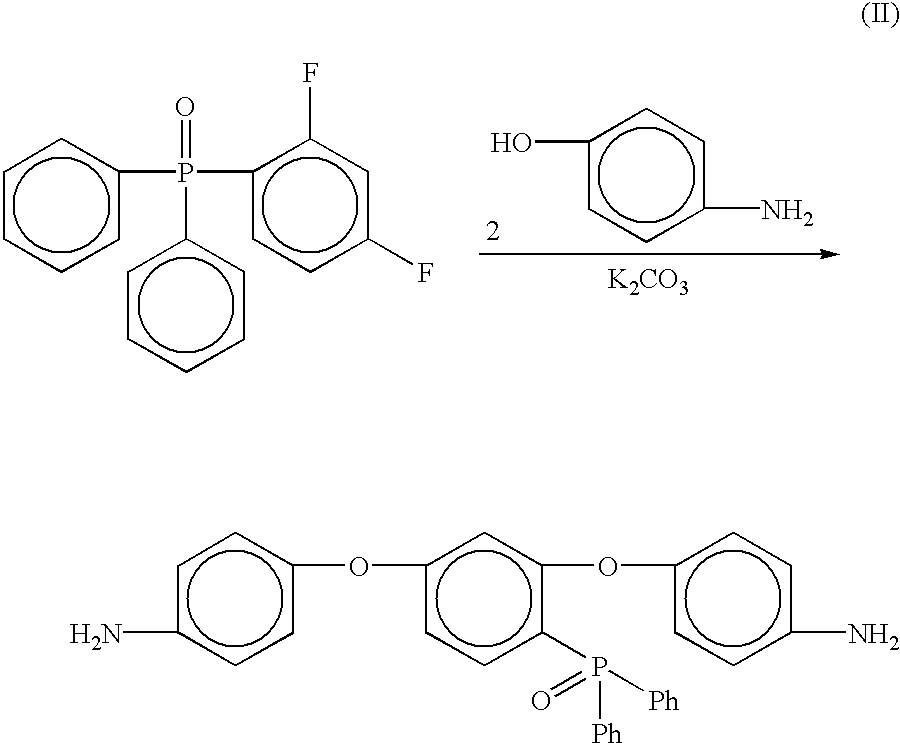Space environmentally durable polyimides and copolyimides
a technology of applied in the field of space environmentally durable polyimides and copolyimides, can solve the problems of poor optical transparency, relatively high solar absorption, and no commercially available polyimides are resistant to degradation, etc., and achieve high glass transition temperature, low color, and high thermal stability
- Summary
- Abstract
- Description
- Claims
- Application Information
AI Technical Summary
Benefits of technology
Problems solved by technology
Method used
Image
Examples
example 1
Preparation of [2,4-bis(3-aminophenoxy)phenyl]diphenylphosphine oxide (3-APPO)
Step 1
Preparation of 2,4-difluorophenyldiphenylphosphine oxide
Into a 1L three neck round bottomed flask equipped with a mechanical stirrer, thermometer, nitrogen gas inlet, pressure equalizing addition funnel, and reflux condenser with drying tube was placed predried magnesium turnings (13.5 g, 0.55 mol) and dry tetrahydrofuran (THF, 50 mL). The mixture was cooled to ˜5° C. using an ice / water bath. A solution of 1-bromo-2,4-difluorobenzene (107.2 g, 0.55 mol, 20% molar excess) in THF (200 mL) was placed in the pressure equalizing addition funnel and added dropwise over a 1.5 hour period. The mixture was allowed to warm to room temperature. The mixture was stirred at room temperature for 3 hours and the flask was subsequently placed in the ice / water bath to cool the solution to ˜5° C. A solution of diphenylphosphinic chloride (107.9, 0.46 mol) in THF (100 mL) was added dropwise over a 1 hour period. The rea...
example 2
Preparation of [2,4-bis(4-aminophenoxy)phenyl]diphenylphosphine oxide (4-APPO)
Into a 500 mL three neck round bottom flask equipped with a mechanical stirrer, thermometer and a Dean-Stark trap equipped with a drying tube was placed 2,4-difluorophenyldiphenylphosphine oxide (12.00 g, 0.0382 mole), 4-aminophenol (8.6673 g, 0.0794 mol), potassium carbonate (13.1682 g, 0.0953 mol), NMP (85 mL) and toluene (25 mL). The mixture was heated to 135° C. while removing water via azeotropic distillation. After 16 hours, the toluene was removed from the reaction and the resulting solution was heated at 165° C. for 4 hours. The reaction mixture was cooled to room temperature and then poured into 1 L of 5% acetic acid (aq) with vigorous stirring. A tan solid formed after stirring for 45 minutes. The crude tan solid was collected via filtration, washed with excess water, and dried in an oven at 110° C. to give 16.76 g (89% crude yield). The solid was recrystallized from a dimethylacetamide / water sol...
example 3
Preparation of [2,4-bis(3-trifluoromethyl-4-aminophenoxy)phenyl]diphenylphosphine oxide (3-AFPPO)
2,4-difluorophenyldiphenylphosphine oxide was prepared as described in Step 1 of Example 1. Into a 100 mL three neck round bottom flask equipped with a mechanical stirrer, thermometer and a Dean-Stark trap equipped with a drying tube was placed 2,4-difluorophenyldiphenylphosphine oxide (7.1654 g, 0.0228 mole), 4-amino-3-trifluromethylphenol (8.52 g, 0.0481 mol), potassium carbonate (8.27 g, 0.0598 mol), NMP (35 mL) and toluene (15 mL). The mixture was heated to 135° C. while removing water via azeotropic distillation. After 16 hours, the toluene was removed from the reaction and the resulting solution was heated at 170° C. for 4 hours. The reaction mixture was cooled to room temperature and then poured into 300 mL of 5% acetic acid (aq) with vigorous stirring. A brown gummy material formed. This material was stirred in warm water, the water decanted, and fresh water added. This process w...
PUM
| Property | Measurement | Unit |
|---|---|---|
| Molar mass | aaaaa | aaaaa |
| Molar mass | aaaaa | aaaaa |
| Angle | aaaaa | aaaaa |
Abstract
Description
Claims
Application Information
 Login to View More
Login to View More - R&D
- Intellectual Property
- Life Sciences
- Materials
- Tech Scout
- Unparalleled Data Quality
- Higher Quality Content
- 60% Fewer Hallucinations
Browse by: Latest US Patents, China's latest patents, Technical Efficacy Thesaurus, Application Domain, Technology Topic, Popular Technical Reports.
© 2025 PatSnap. All rights reserved.Legal|Privacy policy|Modern Slavery Act Transparency Statement|Sitemap|About US| Contact US: help@patsnap.com



